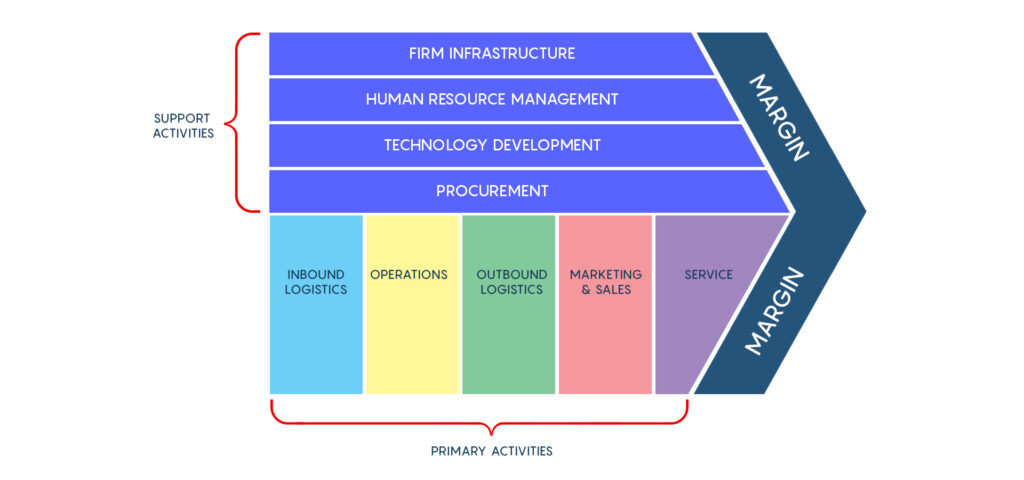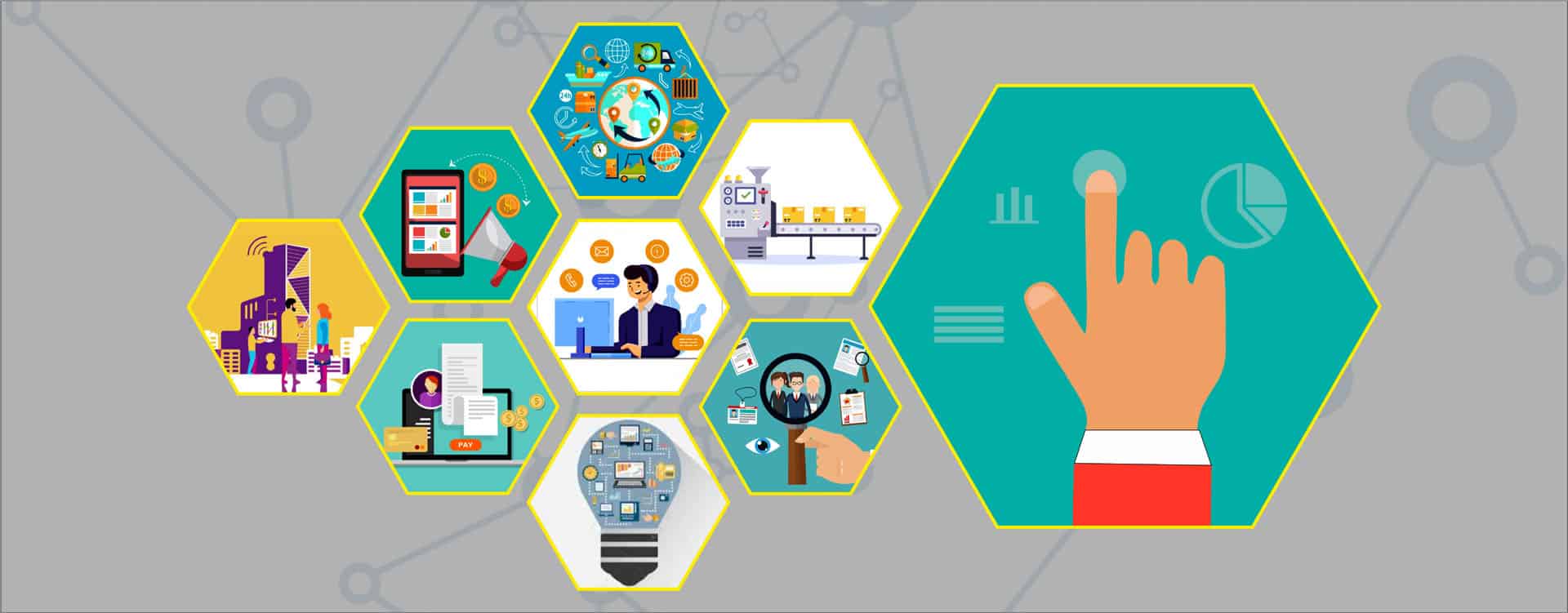You probably have a favourite restaurant or maybe even a specific snack that you like to enjoy from time-to-time – a guilty pleasure. The fact that you keep going back for more means that you find value in that snack or restaurant. This sense of product value is essentially what ‘Porter’s Value Chain’ boils down to. It is the value that your business can provide to the customer. It is not as complicated as it seems, so don’t be afraid. Let’s get into it.
What Is Meant By ‘Value Chain’?
Going in search of these answers online can be quite overwhelming. The ‘Value Chain’ seems like a very complicated term, but it is quite simple. Porter’s Value Chain is a business tool and model that was devised by American economist Michael Porter, in his book Competitive Advantage (1985).
It is essentially a model that companies use to measure the competitive advantage that they have in the market. This competitive advantage is measured by looking at what kind of value the company brings to the table. The higher the value a company can bring, the more competitive advantage it has over other businesses. The results will be higher profits, which translate into growth for the company.

Why It Is Needed And How It Helps
Porter’s Value Chain Analysis has a unique approach. It focuses on how the different components across the company interact and benefit the customers rather than how the departments themselves work. It is very customer-centric in that way and keeps the focus on what really helps a company grow – the customer.
Additionally, it also helps make it clear which areas in the company are lacking efficient performance standards and consequently lacking value in those departments. This allows you to catch it early on and nip it in the bud. Simultaneously it also helps you identify which areas in the company’s performance could be improved to maximise the added value of the product.
‘‘
The quality of a product can be directly linked to the value it brings to the customer as well as the cost and efforts that go into making it available to them.
Porter’s Value Chain Activities Explained
The model, as stated earlier, calculates the value that the product brings the customer and the profits made from it as a result. The profits can be calculated by looking at the total cost of production subtracting that from the price of the product. This value is derived from the nine activities that a company engages in, to add value to said product. The activities that help determine all this are divided into two categories, ‘Primary Activities’ and ‘Secondary Activities’.
The primary activities are directly involved in the production and selling of the product. The secondary activities are supporting activities that coordinate the process across the different primary activities. This ensures a smooth and seamless workflow that maximises efficiency.
Primary Activities
Inbound logistics
This basically refers to the relationship that companies have with their suppliers – the networks through which they receive their raw materials. It also includes the receiving of goods, storage and the internal distribution within the production unit of the company to begin the production process.
Production/Operations
It is the manufacturing stage of the process where the goods are produced. This is where value is added. For example, a hand-crafted leather wallet is much more valuable than a mass-produced leather wallet.
Outbound logistics
Once you have a birthday present ready, you want to wrap it perfectly and make sure it is delivered to your friend on time and safely. This is what outbound logistics is. It is everything to do with packaging and getting the finished product to the customer. This means shipping, storage, transport and distribution to the different stores or points of sale.
Marketing and sales
This stage revolves around informing the customers about the product and helping them find value in it. Once they buy the product, the next step is to provide post-purchase services.
Service
This is just helping your customers after the sales stage. This could be maintenance, customer helplines, customer service, and online/offline consultations. Service is keeping the customers happy.

Secondary Activities
Procurement
It performs the function of purchasing things for the business. Not necessarily the physical raw materials. It supports all the primary activities across the board. This may include arranging transport, the purchase of machinery for the production of the product, or even buying the actual office space for sales operation.
Technology development
Tech development is basically developing the quality of operations in the company, for example, better IT infrastructure, improved ERP (Enterprise Resource Planning) systems, better planning and development tools used among the various departments in the company for seamless workflow.
Human resource management
The HR management concerns itself with activities related to developing and improving the workforce within an organisation. It overlooks the hiring, staffing, training and compensating employees.
Company infrastructure
It gives a business the ability to maintain the day-to-day operations, it is the management, the administration, the finances and even the building itself. It’s an umbrella term, which supports both the primary and secondary activities.
Putting The Value Chain Analysis To Use
Before adopting the value chain model, you need to check if it is required in your company. This helps you identify where your company currently stands, what areas are lacking, and how it is possible for the VCA to be adapted based on the current situation. A thorough look at the business’s existing protocols is essential if you want to successfully implement the VCA for a long period of time.
When it comes down to actually using it, there are a few steps to take to ensure the long-term survival of the business. The price that the customer is willing to pay for the product, should be higher than what it costs to make it. This should be a rule of thumb if a profit is to be made. You need to regularly analyse and update your approach if it is lacking in any areas. This helps the company maintain that competitive edge.
‘‘
Your product should be so good or so convincing that customers should be willing to pay more. The model itself is just a metric of measure that keeps an eye on things, the rest is up to you.
To Use Or Not To Use Porter’s Model
Like any business practice, there are benefits and downsides to adapting a new work model. In terms of advantages, it offers cost reduction, a competitive edge, increased profitability, increased efficiency, reduced waste of time, and high-quality production capacity at low costs. On the downside, the model was crafted based on companies in the 1980s, making it a little outdated to work with and rigid in terms of application.
Porter’s Value Chain is a very linear structure and doesn’t really allow a company to make sudden changes should the need arise. This takes a toll on the creative freedoms and capabilities for change within the company. A business, in this day and age, needs to maintain flexibility and innovation for today’s customers. While the model does not necessarily give much room for innovation, it does have its strengths in terms of helping the business turn a profit and stay ahead of the curve. If you were to implement it, use some discretion and make an informed decision.
Let Us Wrap It Up With An Example
A company who provides auto-parts has recently adopted the VCA model. It would need to look at the different Primary and Secondary activities. It starts with inbound logistics to source the raw materials and then move to the operations phase for manufacturing those parts. Next, outbound logistics comes into play where they ship them to market. In the marketing and sales segment, they sell the parts to the customers. If there is anything wrong with the parts, the customers could then choose to get those parts fixed by the auto-part, from which they bought it – this comes under services.
The secondary activities help support the primary activities through management, finances, infrastructure and salaries. Secondary activities ensure that all the infrastructure is provided for a smooth operation throughout the company.




